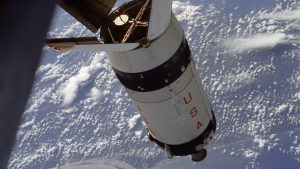By Lauren Stang, Matthew Meyer, Sydney LaBelle, and Jamie Bradfield
The Apollo Missions: Launching
the Way to Discovery
INTRODUCTION
The Apollo missions had their share of successes and failures that have contributed to current knowledge of space and our solar system. The Apollo missions were great endeavors taken on by NASA with goals of putting man on the moon, “establishing the technology to meet other national interests in space, achieving pre-eminence in space for the United States, carrying out a program of scientific exploration of the Moon, [and] developing human capability to work in the lunar environment.” 1 The Apollo missions included twenty-eight missions, many of which failed their mission statement, but each mission had its successes and failures.2 Not only have the Apollo missions helped us learn much more about space, but also the ways in which scientists can carry on conducting research safer than the time before. The question we will be answering is: how have the Apollo missions contributed to our knowledge of the Moon and our solar system?
This article is divided into four sections. The first section provides some background information on The Apollo Program. This portion of the paper will discuss the goals of the missions and whether the missions were successful or not. This section will also dive into specific successes and failures of the missions. The second section of this paper will focus on the behind the scenes heroes of the Apollo mission: Mission Control. This section will explore the importance of Mission Control as well as examine its role within the Apollo Missions. The results of the Apollo Missions will be discussed in the third section. This section will explore how the information gained from the Apollo Missions have shaped current knowledge about space and the solar system. The fourth section will review what scientific advancements have been made due to the Apollo Program and how these advancements have influenced modern-day life. Finally, the conclusion will tie together how all this information gathered from the Apollo Missions have contributed to current knowledge about space and our solar system.
WHAT IS THE APOLLO PROGRAM?
NASA’s Apollo Program began in 1961 when the United States President, John F. Kennedy, “challenged the nation to land astronauts on the Moon by the end of the decade.”3 NASA’s response was the Apollo Program. The name “Apollo” was chosen because there had been a precedent set by the Mercury Missions for naming space exploration projects after ancient Greek mythological gods/heroes.4 The Apollo Program conducted Moon missions, Earth-orbiting missions, and Apollo/Saturn suborbital flights of Earth and beyond.2 Experiments focused on “soil mechanics, meteoroids, seismic [activity], heat flow, lunar ranging, magnetic fields, and solar wind[s].”5 After the near-tragedy of Apollo 13 and accomplishing the goals they set out to achieve, the Apollo Program launched its last mission, Apollo 17, in 1972.6
The Goals of the Missions
The Apollo Missions were created to accomplish six goals:1
- To land Americans on the Moon,
- To develop technology that would benefit the country in these missions and future United States space missions,
- To attain space dominance for the US,
- To establish and implement a program created to study the Moon,
- To establish research methods that allow humans to work in the lunar environment,
- To accomplish all these goals while keeping the crew safe.
The First Catastrophe
The first catastrophe occurred before the first mission was even launched. On January 27th, 1967, during a ground simulation for AS-204 (later renamed Apollo 1 to honor the astronauts that were killed), a fire erupted in the spacecraft.7 The fire took the lives astronauts Gus Grissom, Ed White, and Roger Chaffee and delayed the mission.8
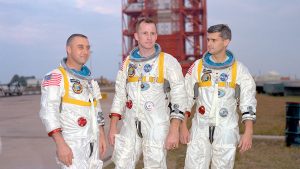
NASA: Apollo 1 Astronauts Left to Right: Gus Grissom, Ed White, and Roger Chaffee
Houston, We Have a Problem
The next mishap began on April 11th, 1970 with the launch of Apollo 13.9 The goal of Apollo 13 was to land astronauts James Lovell, John Swigert, and Fred Haise on a certain area of the Moon, called the Fra Mauro highlands, to collect rock and soil samples.9 This goal was not accomplished.
Just two days after liftoff, disaster struck.10 The spacecraft experienced an onboard explosion.10 The explosion was a result of faulty wiring inside a liquid oxygen tank.11 Oxygen tanks provided the astronauts with air and fuel necessary to complete the mission.11 Swigert was conducting general maintenance of the oxygen tanks, as directed by Mission Control, and as he flipped the switch to stir liquid oxygen tank No. 2, a spark started a fire fueled by pure oxygen.11 Once the astronauts figured out how severe the problem was, the mission’s focus changed from landing on the Moon to surviving.10
The Explosion
The first problem was figuring out how to continue supplying the astronauts with oxygen since the tanks that had been doing that had exploded.11 The only option was to use the lunar module as a lifeboat since it had its own supply of air, water, and power.11 The second problem was determining how to return to Earth since the lunar module did not have the necessary heat protection to enter Earth’s atmosphere.11 They could (a) make a U-turn and make it home as fast as possible, taking a risk on the main engine closest to the explosion and crashing into the Moon, or (b) go around the Moon and use the Moon’s gravity as a slingshot, but this would take longer, and the lunar module was only designed for two men.11 The decision was to go with the second option.11
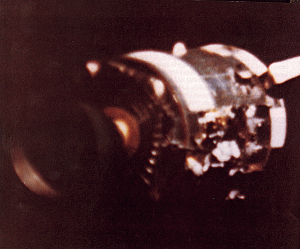
NASA: Oxygen Tank No. 2 Explosion
Goodbye Heat
In order to conserve power, the astronauts had to turn off as many power draws as possible, including the electrical system that controlled the temperature of the module.11 The cold temperature began to freeze the food onboard.11
The Silent Killer
The fourth problem was figuring out how to reduce carbon dioxide build-up.11 The solution was to macgyver an adapter that would allow the square air filters from the command module to fit the round ones in the lunar module.11 Engineers on Earth began designing the adapter using only objects found on the spacecraft (such as duct tape, part of a flight manual, and plastic bags). They then instructed the astronauts on how to recreate their improvisation.11 This solution worked.11 However, another complication arose.
Urine Rockets
The astronauts were instructed by Mission Control to stop excreting bodily fluids outside the spacecraft to prevent unbalanced forces.11 Had they continued to do this, they would have altered the path of the module which would have affected re-entry into Earth’s atmosphere.11 As a result, the astronauts drank as little water as possible which led to dehydration and, as Haise would experience firsthand, infection and fever.11 However, this was not the last problem these astronauts would face.
All This for Nothing?
The crew was informed by Mission Control that, according to calculations, their spacecraft was going to miss Earth’s atmosphere due to an unknown source of drifting.11 The solution was to fire the rockets manually to steer the module back on course, a technique that was unprecedented.11
The command module had not been started for several days, so Mission Control and the astronauts had to communicate back and forth a more than 500-step checklist in order to face this challenge.11 The module started and, with the hope that the heat shield remained undamaged, the astronauts began their journey into Earth’s atmosphere on April 17th.11
Home Sweet Home
There was a blackout in communication between Mission Control and the Spacecraft as the spacecraft re-entered the atmosphere, but when Mission Control received confirmation that the crew was alive, the stress of the past four days was immediately relieved.11
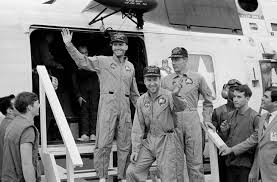
NASA: Apollo 13 Astronauts Fred Haise, Mission Commander James Lovell and John Swigert (from left to right) Return to Earth
Successful Failure
Avoiding another tragedy was a success in itself, and thus Apollo 13 is referred to as a ‘successful failure.’12 Although one might argue Apollo 13 failed at achieving its goal of landing on the moon, it taught Mission Control how to deal with things when they do not go according to plan. Many discoveries that have shaped current understanding of space and the solar system have not gone according to plan.
Although the Apollo Program experienced multiple difficulties throughout its lifespan, overall, it was extremely beneficial in contributing to current knowledge about space and the solar system. The main goals of the Apollo Program were to land men on the Moon and to return them safely home, both of which were accomplished during the program.5 Six of Apollo’s missions (Apollo 11 through to Apollo 17) landed men on the Moon and advanced modern science through the samples that were collected.5 Only one of Apollo’s many missions failed to keep the crew safe (Apollo 1). Without successfully accomplishing these goals, many of the developments that have been made due to the Apollo Program would not have existed. The goals and successes of the Apollo Program are what drove the advances in current knowledge about space and the solar system.
THE IMPORTANCE OF MISSION CONTROL
Astronauts are considered the stars of the show when it comes to the Apollo missions, but little light shines on the people behind the scenes. Mission Control made huge contributions towards the U.S manned space flights. Engineers, Mathematicians, Physicists, and many others assisted with the successes and achievements of these missions. Mission Control Centre, located at NASA’s Johnson Space Center in Houston, supports astronauts throughout their missions and manages space flight.13 The room is filled with rows of computers, gauges, meters, monitors that constantly gather and output new information. They monitor fuel levels, exact timing for maneuvering, astronauts’ vital signs, electrical and life support status, lunar module and its equipment, and other aspects of the mission and spacecraft. Mission Control was responsible for the overall progress and planning of the missions, and they oversaw all crucial details of human space flight.14 Astronauts rely on Mission Control’s every word and, without their detailed research and organization, the Apollo missions would have been a no-go.
The People Behind the Scenes
Over 400,000 people worked endlessly to achieve something that was never done before: landing man on the Moon.15 They were unaware of what to expect about the environment and mechanical aspects.16 Despite the unknown, the previous Gemini mission had prepared them for the Apollo missions and any challenges they faced along the way. These people endured hours of hard work to assure the astronauts safely completed the mission. 75% of their time was spent planning and organizing for the specific Apollo mission, 15% to training and education for themselves to maintain standards for the missions and 10% controlling the missions.17
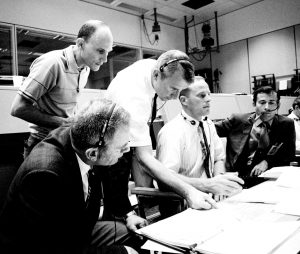
NASA: Members of the Apollo 13 Team
Mission Control Operation Room
The team is divided into different groups that monitor different areas of the mission. Each team has their own tasks and responsibilities that contribute to the overall success of a mission. The Mission Control Operation Room (MCOR) consists of four rows with each row and section operating its own tasks. They needed to develop technology such as computers, radars, and radios to communicate between the spacecraft and mission control.15 The ‘trench’ is the lowest of the row of consoles and is considered the first line of defense. This row consists of a retrofire officer, flight dynamics officers and guidance officers. They guide astronauts through maneuvers to keep the spacecraft on its proper flight path. The team is responsible for all aspects of the mission including spacecraft computers, fuel tanks and exact maneuvers for the space flight. The second row is where the flight doctor monitors the heart rate, breathing, and other vital signs during the space flight. ‘Capcom’, the capsule communicator, receives and sends messages to the astronauts. The flight director sits in the third row where they monitor the overall progress of the mission . The back row consisted of the public affairs officer, Department of Defense liaison, Mission Director and the Director of Flight Crew Operations.18
For Apollo 11, the teams were split into two groups: the ground-team and flight control. The ground-team gathered data from the spacecraft and launch facilities, and flight control would use that data to make decisions on how best to proceed.13 The data they gathered allowed Mission Control to accurately and safely determine precise procedures needed for a successful mission. They were always changing and modifying the mission’s plans so they were ready for any challenges they encountered. Apollo 11 is monumental for the control team and paved the way for future manned space missions.
After Apollo 1’s tragic loss, Mission Control analyzed what went wrong. The loss changed the attitudes of future space flights.16 The team analyzed their techniques and designs of the spacecraft and mission and became more diligent to ensure safety throughout the missions. NASA also established the Senior Flammability Test Review Board that developed a flammability test to assure redesigned spacecraft were less of a fire hazard.19
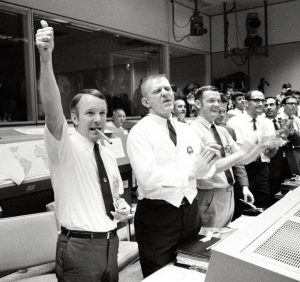
NASA: Members of the Apollo 13 Team Celebrating Safe Landing
The Apollo 13 mission demonstrated the knowledge and capabilities of Mission Control. Failure was not an option. Mission Control worked with the astronauts to overcome multiple obstacles and make critical decisions in order to return the astronauts home safely. Years of planning, simulations, and testing is what Mission Control has done to assure the safety of manned missions.16 Despite the tragic loss Apollo 1 and the failures of Apollo 13, Mission Control was able to come up with new innovative procedures.
Gene Cernan (2017), NASA Apollo 17 astronaut states:
We the astronauts, we were always the tip of the arrow, but Mission Control were sort of like the feathers. They pointed us in the right direction. They made sure we were going to get where we wanted to go and get home safely.15
Mission Control had the biggest impact on future space expeditions. The principles and foundations used during the Apollo missions are still being used today. Astronauts rely on Mission Controls every word and with the team from Mission Control then communication from spacecraft to earth would not be possible. Many obstacles were faced and goals accomplished through Mission Control’s dedicated work.
APOLLO MISSION DISCOVERIES
A few of the important Lunar discoveries tell its historical geological composition, origin of craters, lifelessness, the asymmetrical shape of the moon, and that the moon is an evolved terrestrial planet that contains internal zoning similar to that of earth.20 While the Apollo missions focused most of their discoveries on the moon, corresponding programs and projects such as the NASA Langley Research Centre, Lunar-orbiter rendezvous, and Skylab made important contributions to scientific knowledge space and future endeavours. Utilizing ever-advancing technologies, new discoveries were made possible.
Lunar Discoveries
One of the first things that the astronauts on Apollo 11 encountered and confirmed, was the solid surface on the moon. At the time there was no way of knowing how safe the lunar surface would be for human exploration other than by the astronaut’s observations and judgements.21 During the first Apollo mission that successfully landed on the moon, there were 49 pounds of moon rocks and lunar dust that were returned to earth with the astronauts. Apollo 11’s contribution of physical evidence from the moon alone was enough to inspire a wave of scientific discovery about our moon. 6 months after Apollo 11 had returned the first samples from the moon, the journal Science published an issue directly related to lunar science. With 150 scientific articles discussing new lunar scientific discoveries, most of them with regards to the studying of the samples returned to earth from another planetary object.22 From the following Apollo lunar missions, over 800 pounds of moon rocks were collected and returned to earth for research. The rocks collected from the moon over the span of the Apollo missions have been dated to age of 3.2 billion years old to nearly 4.6 billion years old.21
From the analyses of certain fragments of rock, scientists were able to confirm a theory of how the moon was formed. Material with a large amount of natural glass, formed when meteorites struck the moon.23 The glass was dated to more than 4 billion years ago, preserved by the lack of water and atmosphere on the moon, giving scientists insights into the earlier days of the solar system.23 Like the discovery of natural glass, the discovery of Anorthosite in mass volumes also contributed to telling the moon’s geological composition and piecing together history. Anorthosite is igneous rock that is found on the Earth and the Moon, with some differences due to the lack of liquid water on the moon. Formed from the crystallization and flotation of Plagioclase (A type of feldspar) in the Lunar Magma Ocean.24
Understanding how Lunar rocks formed is key to understanding the formation of terrestrial planets. Discovering anorthosite indicated that complex geological processes once existed on the moon, confirming the theory that the Moon was once a part of Earth, and was blown off after a collision with another large planetary-sized object. This discovery allowed scientists to create theories of how other planets, and their moons have been created.
To know just how ground-breaking the Apollo missions were in our understanding of the moon as well as other planetary objects in our solar system, once the astronauts had returned to earth on the Apollo 11 mission, they were put into quarantine as to not infect anyone with potentially harmful space microorganisms. Additionally, part of the testing that was done on the moon rocks was to see if they would potentially be hazardous to life on earth, and the scientists in contact with the moon rocks were put under quarantine as well. Some moon rocks were ground into fine ‘space dust’ and injected into mice and quail, fed to insects, put into aquatic species habitats, and even tested space dust in plants soil. All in a quarantined environment.21 It was until after Apollo 14 in 1971 that it was concluded that the lunar material was non-hazardous to life on Earth. In fact, with the plant tests, “seeds germinated in the presence of lunar materials grew vigorously.” 25
The Lunar Orbiter Rendezvous Project
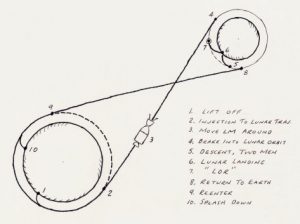
The Lunar Orbit Rendezvous Project
The Apollo missions opted to go with Lunar-Orbit Rendezvous (LOR), to get the astronauts to and from the moon. This method had been theorized before, but like other aspects of the Apollo missions, the first applications were ground-breaking. A command module would detach and Chosen over the Earth-orbit Rendezvous, and Direct ascent methods, it was Lunar-orbit rendezvous using the Saturn V rocket that made the moon landings possible.23
This assembly would include 3 stages on top of the Saturn V Rocket; (1) a mother ship or command module (CM); (2) a service module (SM) containing the fuel cells, attitude control system and main engine; and, (3) a small lunar lander or excursion module.23 This method may have been the most complicated and riskiest out of the options NASA had considered, but the advantages to LOR made NASA’s decision clear. Requiring less fuel, only half of the payload, and less new technology to be engineered than the other two methods.23
Remote Sensing
As the Apollo missions project had been cancelled, Skylab was launched into orbit during the last missions, and utilized the technology that was left over from the wound down Apollo program. The Apollo command module was used to transport astronauts to and from the Skylab, and the Apollo Telescope module contained telescopes for solar observations.26 Skylab was the United States first Space Station, and effectively acted as a laboratory in Earth’s orbit.26 In addition to earth observations, sea-surface radar altimetry was Skylab’s ground-breaking earth-resource observation. The Altimetry experiment was able to accurately map the oceans geoid to -1m/+1m. Other important work utilized telescopes on the Skylab to include observations of the sun. Discoveries show Coronal holes which are the site of geomagnetic activity, identified as the dark regions seen on images of the sun, and X-ray bright points that appear uniformly across the sun’s surface. 27 From the images collected from Skylab, it was estimated that there were 1500 bright spots appearing per day, leading to more new magnetic flux to the surface than is contributed by the major active regions.28
ADVANCEMENTS MADE DUE TO THE APOLLO MISSIONS
The Apollo missions were incredibly successful in more ways than NASA’s original mission statement. Not only did man step foot on the Moon for the first time, but the advancements made by NASA to make the missions possible have also benefited everyone on Earth. As stated by Sharon Gaudin, “it [is] fairly well-known that technology developed by NASA scientists routinely makes its way into products developed in the robotics, computer hardware and software, nanotechnology, aeronautics, transportation, and healthcare industries.” 29 Some examples of daily-use items that were enhanced or created because of the Apollo missions include: solar panels and cordless tools and appliances.30 Along with the practical, everyday items, the Apollo missions also gave information about our Moon and solar system that can allow scientists to slowly piece together the massive puzzle that is our solar system.
Everyday Advancements
The Apollo missions are best known for the advancements they have made in science, but there are also everyday applications of products and concepts that have been invented or improved for the purposes of the Apollo missions. Some of these include solar panels and cordless tools and appliances.

NASA: Solar Panels used on Earth
Solar panels were used by NASA as a way to get energy to a spacecraft while it is carrying out its mission. As a spacecraft’s only option for obtaining constant energy, solar panels are always being improved by NASA to ensure that future endeavors in space are successful.31 This continual improvement will benefit people on Earth as the solar panels will get better and cheaper.
NASA was successful in using the concept of cordless appliances during the Apollo missions and from those innovations, Black & Decker created cordless tools that are “lightweight battery-powered precision instruments designed to give surgeons optimum freedom and versatility in the operating room.”30 Cordless tools such as electric drills were also created because of NASA’s innovations. Innovations like these are very helpful in the everyday life of an average person, so the work NASA is doing not only benefits themselves and other space agencies, but they are benefiting everyone.
Scientific Advancements
The Apollo missions helped scientists learn more about the technology that is needed to perform successful missions into space. Technology has advanced so much since the Apollo missions because of how much effort, time, and money went into learning more about how we can safely traverse the solar system. Spacesuits and computers have been innovated immensely since the Apollo missions, and the Skylab space station was an immediate consequence of the Apollo missions.
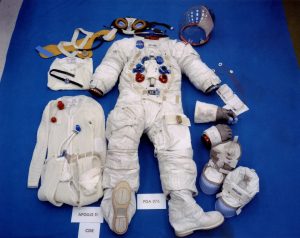
NASA: Neil Armstrong’s Space Suit for the Apollo 11 Mission
Spacesuits were custom-tailored for the Apollo missions and as the missions went along, the suits changed based on the mission as the requirements for the suit changed along with it. The suits had many layers to “maintain pressure and protect the astronauts from radiation and micrometeoroids.”32 The suits also included gloves that could help astronauts “feel” the things they pick up, lunar boots to help them walk on the moon, a helmet that did not move as the astronaut moved their head and a portable life support system to help support astronauts while they are off the spacecraft for up to seven hours.32 Such innovations in the production of the space suits have led to better protection of astronauts while outside of the spacecraft, which, in turn, leads to safer expeditions into space.
The Skylab was America’s first space station that was created as a way to use unused hardware from the Apollo missions. According to NASA, “on May 14, 1973, the final Saturn V rocket thundered off Launch Pad 39A at Kennedy Space Center to lift the Skylab space station into orbit.”33 Skylab experienced issues with the micrometeoroid shield upon takeoff as it deployed before the station was in orbit. After studying the problem with the micrometeoroid shield, NASA believed the problem was that the shield was unable to withstand the high air currents of launch. From this, engineers were able to learn more about how to build spacecrafts to be more durable.33 Alongside the issues faced by the crew, they “conducted 270 experiments in biomedical and life sciences, Earth observations, solar astronomy and materials processing.”33 The mission was a success in conducting the tests they needed to, but also in learning how to better spacecrafts for future flight.
NASA experienced many accidents during the Apollo missions that helped them become more successful with future space endeavors. NASA’s innovation in technology has benefited the world largely, leading to much more efficient and practical innovations and inventions at the household level as well as the medical level.
CONCLUSION
The Apollo Missions greatly contributed to modern knowledge about space and the solar system. Although the first Apollo mission ended in tragedy, and Apollo 13 nearly ended the same way, the rest of the missions were extremely successful. The advancements that have been made due to the Apollo Missions have completely altered the way that scientists view the world of astronomy, as well as how we live our lives on Earth. As Ian Crawford states, “ . . . I think one could reasonably make the case that Apollo laid the foundations for modern planetary science, certainly as it relates to the origin and evolution of the terrestrial planets.”23 The Apollo missions paved the way to new discoveries of the earth, the Moon, and of the solar system. Apollo missions set the standard for what could be achieved from a scientific perspective of exploring our solar system. The successes, and failures, resulting from this program contributed to confirming theories and satisfying the curiosity that exists in stargazers and scientists alike.
REFERENCES
1 NASA. The Apollo Missions. https://www.nasa.gov/mission_pages/apollo/missions/index.html (Accessed 22 February 2020).
2 D. Williams, The Apollo Program (1963 – 1972). https://nssdc.gsfc.nasa.gov/planetary/lunar/apollo.html (Accessed 22 February 2020).
3 NASA. What Was the Apollo Program? https://www.nasa.gov/audience/forstudents/5-8/features/nasa-knows/what-was-apollo-program-58.html (Accessed 12 March 2020).
4 H. Wells, S. Whiteley, C. Karegeannes, Manned Space Flight – NASA History Division. https://history.nasa.gov/SP-4402/ch4.htm (Accessed 14 March 2020).
5 Smithsonian National Air and Space Museum. The Apollo Program. https://airandspace.si.edu/explore-and-learn/topics/apollo/apollo-program/ (Accessed 14 March 2020).
6 Smithsonian National Air and Space Museum. End Of An Era. https://airandspace.si.edu/exhibitions/apollo-to-the-moon/online/later-missions/end-of–era.cfm (Accessed 16 March 2020).
7 E. Howell, Apollo 1: The Fatal Fire. https://www.space.com/17338-apollo-1.html (Accessed 16 March 2020).
8 Smithsonian National Air and Space Museum. Apollo 1 (AS-204). https://airandspace.si.edu/explore-and-learn/topics/apollo/apollo-program/orbital-missions/apollo1.cfm (Accessed 13 March 2020).
9 NASA. Apollo 13. https://www.nasa.gov/mission_pages/apollo/missions/apollo13.html (Accessed 17 March 2020).
10 History.com Editors. Apollo 13 Oxygen Tank Explodes. https://www.history.com/this-day-in-history/apollo-13-oxygen-tank-explodes (Accessed 17 March 2020).
11 R. Mastri, 2012. Apollo 13 The Real Story. https://www.youtube.com/watch?v=69LDSL-9–g [youtube video]. (Accessed 17 March 2020).
12 NASA. A Successful Failure. https://www.nasa.gov/image-feature/a-successful-failure (Accessed 17 March 2020).
13 S. Canright, People Behind the Astronauts. https://www.nasa.gov/audience/foreducators/k-4/features/F_People_Behind_the_Astronauts.html (Accessed 16 March 2020).
14 G. Sparrow, Apollo 11 Mission Control: the people behind the Moon landing. https://www.skyatnightmagazine.com/space-missions/apollo-11-mission-control-the-people-behind-the-moon-landing/ (Accessed 18 March 2020).
15 D. Fairhead, Mission Control: The Unsung Heroes of Apollo (2017). Netflix https://www.netflix.com/ca/title/80175483 (Accessed 19 March 2020).
16 D. Kendall, Mission Control and the Moon Landing. https://spacecentre.co.uk/blog-post/mission-control-and-the-moon-landings/ (Accessed 19 March 2020).
17 S. Canright, Mission Control Gets Us Into Space. https://www.nasa.gov/audience/forstudents/9-12/features/F_Mission_Control_Gets_Us_Into_Space.html (Accessed 16 March 2020).
18 American Experience, The Trench: The People at Mission Control. https://www.pbs.org/wgbh/americanexperience/features/moon-trench-people-behind-mission-control/ (Accessed 18 March 2020).
19 NASA. 50 Years Ago: Apollo Flammability Test. https://www.nasa.gov/feature/50-years-ago-apollo-flammability-tests (Accessed 19 March 2020).
20 Smithsonian National Air and Space Museum, Apollo Results. https://airandspace.si.edu/explore-and-learn/topics/apollo/apollo-program/apollo-results/ (Accessed 18 March 2020).
21 M. Bartels. NASA Fed Apollo 11 Moon Rocks to Cockroaches. https://www.space.com/apollo-lunar-samples-safety-animal-testing.html (Accessed 18 March 2020).
22 N. T. Redd. Apollo 11 Was a Voyage of Discovery About Our Solar System. https://www.space.com/apollo-11-moon-landing-science-legacy.html (Accessed 19 March 2020).
23 NASA. What we Learned. https://www.nasa.gov/specials/apollo50th/learn.html (Accessed 18 March 2020).
24 Tatsuyuki. A., Shigenori. M. Formation of anorthosite on the Moon through magma ocean fractional crystallization. https://www.sciencedirect.com/science/article/pii/S1674987116302043. Accessed 23 March 2020).
25 G.R. Taylor, B.J. Mieszkuc, R.C. Simmonds, and C.H. Walkinshaw, Biomedical Results of Apollo (1972). https://history.nasa.gov/SP-368/s5ch2.htm (Accessed 18 March 2020).
26 E. Howell. Skylab: First U.S Space Station https://www.space.com/19607-skylab.html (Accessed 19 March 2020).
27 D. Hathaway. The Skylab Missions. https://solarscience.msfc.nasa.gov/Skylab.shtml (Accessed 20 March 2020).
28 L. Golub., A. S. Krieger., J. K. Silk., et. al. Solar X-Ray Bright Points. http://adsabs.harvard.edu/full/1974ApJ…189L..93G (Accessed 20 March 2020).
29 S. Gaudin, NASA’s Apollo Technology has Changed History. https://www.computerworld.com/article/2525898/nasa-s-apollo-technology-has-changed-history.html (Accessed 15 March 2020).
30 NASA. Benefits from Apollo: Giant Leaps in Technology. https://www.nasa.gov/sites/default/files/80660main_ApolloFS.pdf (Accessed 15 March 2020).
31 N. Chandler, How Has NASA Improved Solar Energy? https://science.howstuffworks.com/innovation/nasa-inventions/nasa-improve-solar-energy.htm (Accessed 15 March 2020).
32 E Howell, Apollo 11’s Vintage Tech: The Most Amazing Moon Landing Innovations. https://www.space.com/26630-apollo-11-vintage-tech-innovations.html (Accessed 15 March 2020).
33 NASA. Skylab: America’s First Space Station. https://www.nasa.gov/feature/skylab-america-s-first-space-station (Accessed 15 March 2020).
